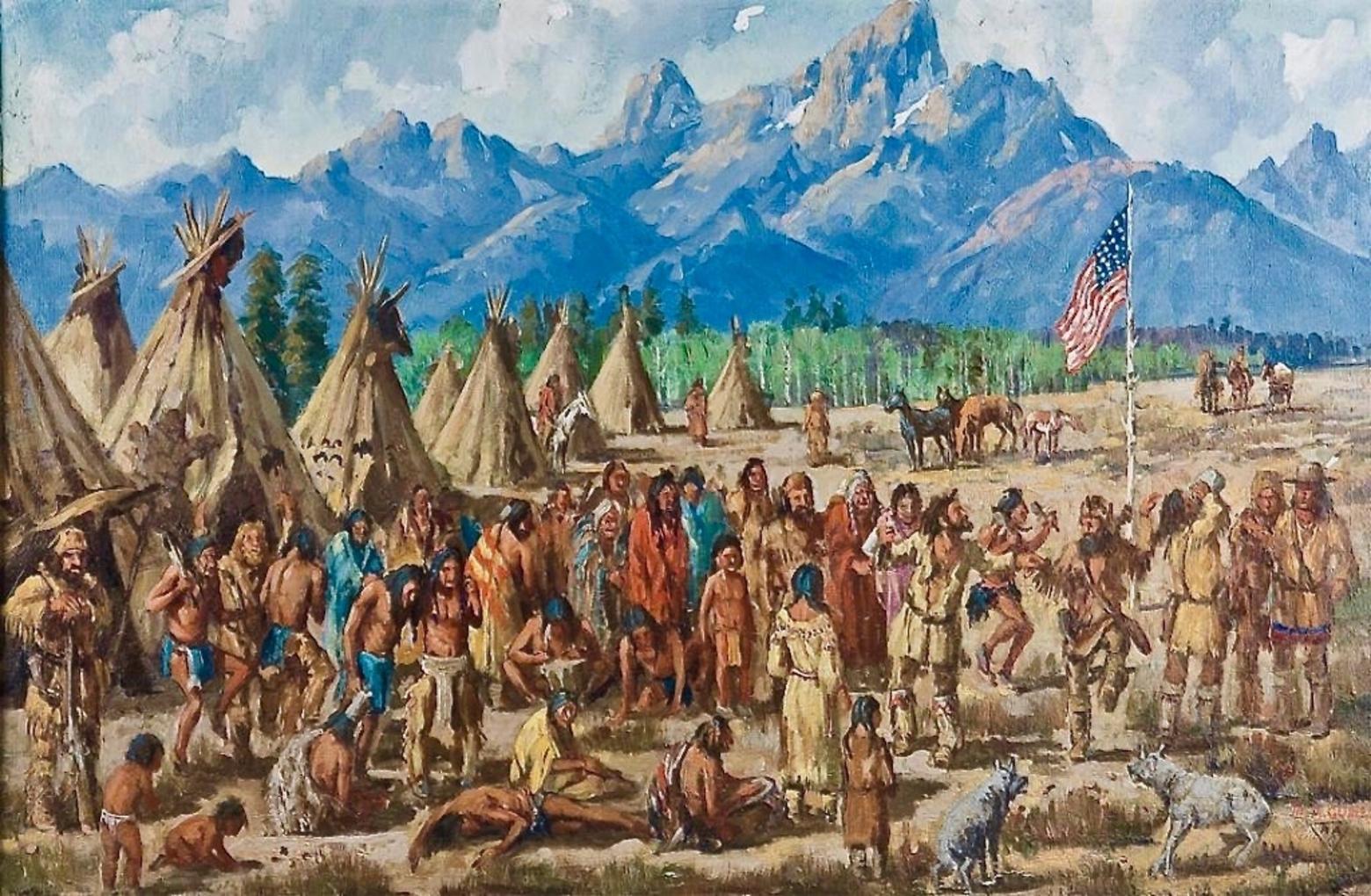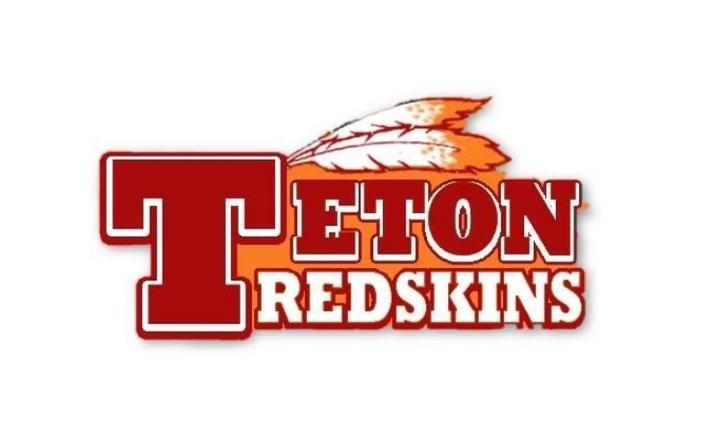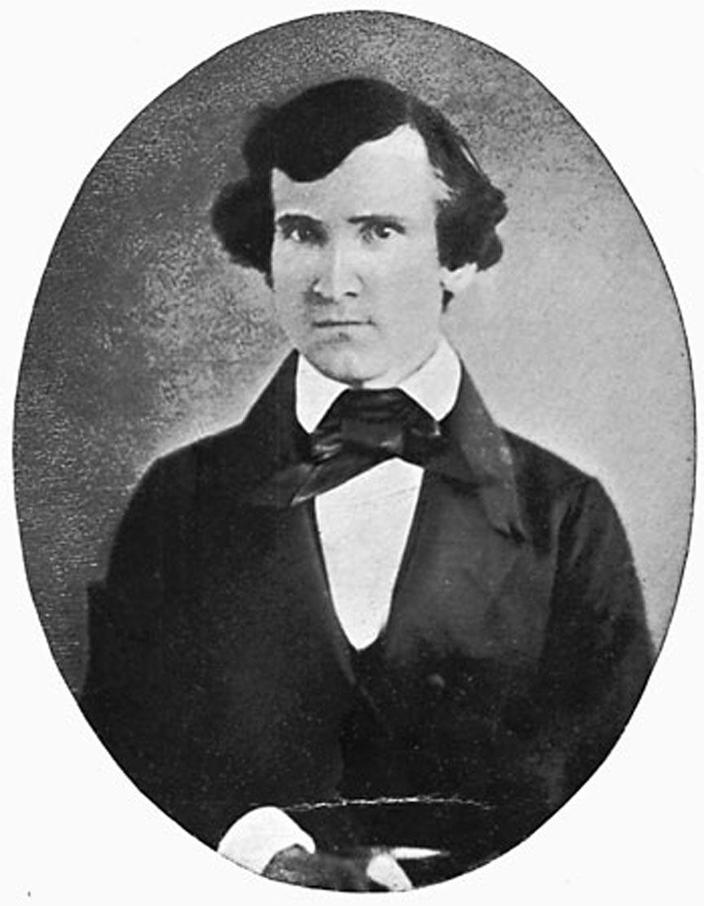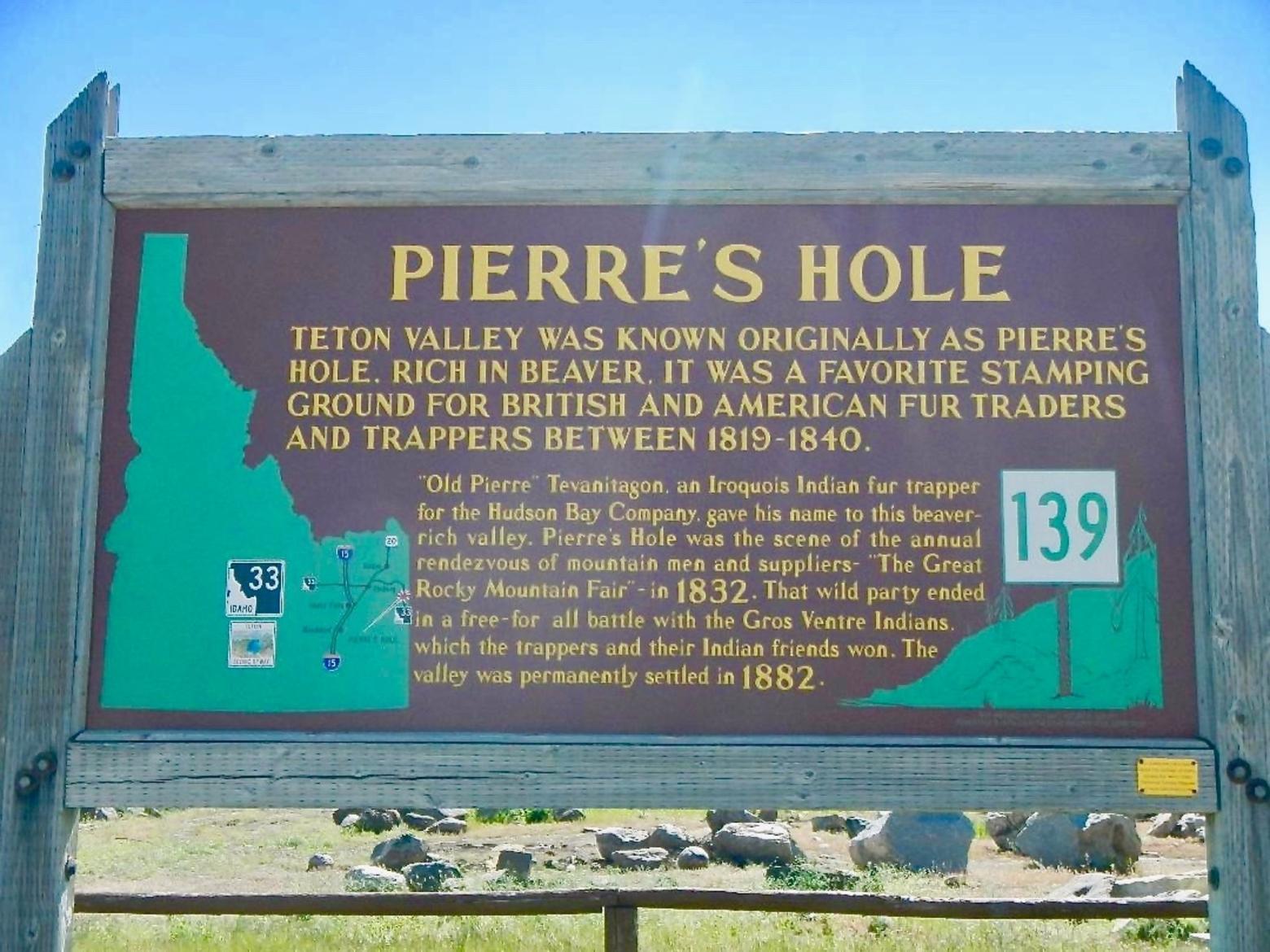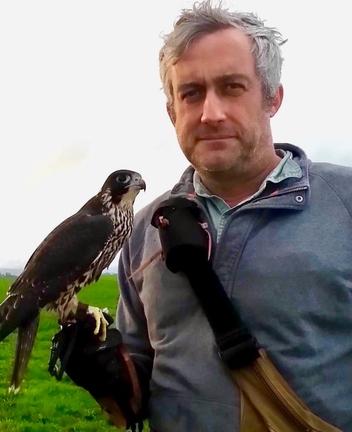Back to StoriesWhen Cultures Collide
One hundred and eighty-seven years ago this summer, the largest battle of the Rockies erupted in Teton Valley, west of Jackson Hole, Wyoming, near what is today Driggs, Idaho. Lasting all day, the Battle of Pierre's Hole ended with several dozen dead including native inhabitants, trappers and explorers.
July 30, 2019
When Cultures CollideFrom the Battle of Pierre's Hole to debate over an offensive high school mascot, Teton Valley is a perfect place for historical reflection
One hundred and eighty-seven years ago this summer, the largest battle of the Rockies erupted in Teton Valley, west of Jackson Hole, Wyoming, near what is today Driggs, Idaho. Lasting all day, the Battle of Pierre's Hole ended with several dozen dead including native inhabitants, trappers and explorers.
While a number of Rocky Mountain Rendezvous sites captured the pride of place in the chronicles of fur trading history, the July Rendezvous at Pierre’s Hole was the jewel; offering superior grazing for tired horses, abundant game, and extraordinary beauty. The famous mountain man Jim Bridger pronounced it “the finest valley in the world.”
Unfortunately, the Battle of Pierre’s Hole, like so many tales of the Old West, has since fallen from the mantel of essential history, and now commemorated only with a road marker, a pull-out, and an interpretive sign – overlooking a long-since altered landscape.
Over recent months, Teton High School in Driggs, Idaho has received national attention as the community grapples with delicate subjects and the future of their long-held mascot, the “Redskins.” The debate about Native American sports mascots across the nation has largely revolved around a subtext of pernicious racism, however another theme, equally as consequential, still languishes among forgotten ghosts.
The after-shock of the Battle of Pierre’s Hole was recorded in the accounts of many trappers and explorers, but no other source conveyed the wild and chilling atmosphere of the time like John Kirk Townsend. In 1839, John Kirk Townsend published his journal entries in a book entitled “A Narrative of a Journey Across the Rocky Mountains to the Columbia River.”
Townsend and his colleague Thomas Nuttall were, arguably, the first scientifically trained naturalists to explore the interior Rockies and Pacific Northwest while attached to Nathaniel Wyeth’s expedition of 1834, who himself was a participant in the Battle of Pierre’s Hole only two years previous.
Tales of the Old West were often plagued by the literary inventions of fame-seeking entrepreneurs, but trained naturalists were another thing. Their notes and diary entries were intended for their scientific colleagues, and their journal writing often produced the most exhaustively detailed and credible accounts we have.
In the case of Townsend, his journals were an important contribution to our understanding of the relative abundance and distribution of wildlife species before Euro-American settlement changed the West forever. But Townsend was possibly more captivated by his encounters with Native Americans and described these in great detail, much to the annoyance of artist, naturalist and ornithologist John James Audubon who purchased many of his bird skins and grumbled that Townsend's notes on bird habitat, behavior, and specimen locations were far too sparse.
Unbeknownst to Audubon, the life of the specimen collector in the “western frontier” was a different matter than the countryside collecting trips of a Philadelphian. All manner of precaution mentioned in Townsend’s notes seemed focused on defensive tactics against aggressive native inhabitants, imagined or real, which tempered the child-like enthusiasm of a field biologist savoring new land and chasing new creatures over the next ridgeline.
As soon as the expedition that included Townsend and others left the settlements of eastern Missouri, the names “Pawnee” and “Blackfoot” were uttered as ominous warnings. Instead of recounting the songs of prairie bird species new to science, Townsend devotes pages to the defensive arrangement of horses and wagons at each day’s camp, the protocol for night watch, and the punishment for sleeping on duty.
“The captain cries the hour regularly by a watch, and all's well, every fifteen minutes, and each man of the guard is required to repeat this call in rotation, which if any one should fail to do, it is fair to conclude that he is asleep, and he is then immediately visited and stirred up. In case of defection of this kind, our laws adjudge to the delinquent the hard sentence of walking three days.”
Townsend’s expedition leader Captain Nathaniel Wyeth escaped death at the Battle of Pierre’s Hole two years earlier, and two of the battle’s key players were now attached to Wyeth’s group on this second expedition; Antoine Godin, a respected guide and hunter, and Milton Sublette, a leading fur trader called “the Thunderbolt of the Rockies,” referring to his reputation for impetuous action.
These experienced hands recited the Battle of Pierre’s Hole to the green horns or “Eastern tenderfoots,” and the formidable strength of the “Blackfoot” was repeatedly emphasized. Townsend listened, as an escalating mood of fear and exuberance filled the journal pages to come.
The first indigenous peoples encountered by Townsend, however, were a delegation from the Sac and Fox tribe (Thakiwaki or Sa ki wa ki), in the midst of a treaty negotiation. Although Townsend describes them as “fantastically painted” with a deep red paint, the encounter was in the context of a civil negotiation replete with professional translators and peaceful intentions conveyed to all parties.
But after leaving the Sac and Foxes and trading with Kansa, the expedition soon encountered two men on horseback along the broad prairie near the Platte River. No translator is available, but Wyeth rides out to meet them and determines they are the feared Pawnee, whom some called “The Wolves,” or Chatiks si chatiks ,meaning "Men of Men."
The Pawnee scouts somehow convey to Wyeth that 1,500 warriors from their band are encamped within a day’s ride. Wyeth thus tries to convince the Pawnees that his group is only to ride a few more miles and camp nearby for the night. The parties separate and when out of sight of each other, Wyeth orders his men into a desperate run for two days to out-pace the Pawnee, known for their horsemanship and skill in battle. On both sides, confusion and ad hoc counter-intelligence ruled their brief encounters.
Just days later Townsend returned to his tent after completing his midnight watch duty, and as he laid down to sleep:
“I was startled by seeing a pair of eyes, wild and bright as those of a tiger, gleaming from a dark comer of the lodge (tent). My first impression was that a wolf had been lurking around the camp, and had entered the tent in the prospect of finding meat. My gun was at my shoulder instinctively, my aim was directed between the eyes, and my finger pressed the trigger. At that moment a tall Indian sprang before me with a loud wah! seized the gun, and elevated the muzzle above my head; in another instant, a second Indian was by my side, and I saw his keen knife glitter as it left the scabbard. I had not time for thought… when Captain W., and the other inmates of the tent were aroused, and the whole matter was explained, and set at rest in a moment. The Indians were chiefs of the tribe of Pawnee Loups, who had come with their young men to shoot buffalo: they had paid an evening visit to the captain, and as an act of courtesy had been invited to sleep in the tent.”
Even for the mild-tempered Townsend, a Quaker, an Abolitionist, and a trained scientific observer – identifying who was friend or foe was bewildering and elusive as he ran from the Pawnee one day, and shared tight quarters with them the next. Townsend recounts the awkward morning greetings with his midnight combatants:
“the taller one, my opponent of the previous night,—rose to his feet, walked towards me, and gave me his hand with great cordiality; then pointed into the tent, made the motions of raising a gun to his shoulder, taking aim, and in short repeated the entire pantomime with great fidelity, and no little humor, laughing the whole time as though he thought it a capital joke. Poor fellow! It was near proving a dear joke for him, and I almost trembled as I recollected the eager haste with which I sought to take the life of a fellow creature.”
They pushed on into what is now western Nebraska, then Wyoming, and Townsend’s trepidations about the feared “Blackfoot” become a nearly daily ritual in his journal entries. This time, Wyeth chose to avoid the summer trapper Rendezvous at Pierre’s Hole altogether, out of fear of this warrior tribe and a repeat of bloodbath that ensued several months earlier.
As with so many Indian names ascribed by Euro-American explorers and trappers, “Blackfoot” was a vague exonym; a term referring to the sooty black color of moccasins from walking on burnt prairie – a tell-tale sign of a tribe of the western Great Plains.
However, Wyeth, Sublette and other seasoned traders were referring specifically to what is now called the Blackfoot Confederacy,Niitsitapi or Siksikaitsitapi,a decentralized group of tribal nations that ranged widely across the northern front range and arid western plains in pursuing buffalo and visiting allies. They shared a common language based on the Algonquin language family and their tribal divisions included the Siksika ("Blackfoot"), theKainai or Kainah("Blood"), and the Northern Piegan or Peiganor Piikani (Apa’toseeor "Poor Robes") and the Southern Piegan/Piegan Blackfeet (Amskapi Piikanior Pikuni).
It is unclear which of these tribes or divisions of the Blackfoot Confederacy carried the fearsome reputation or even if Euro-Americans at the time had any inkling of the differences. To add the confusion, the region was also home to another “Blackfoot” - the Sihásapa or Blackfoot Sioux, or Western Sioux; a division of the Lakota people also called Titonwan, or Teton; a completely different tribe with different alliances.
The alliances of the Blackfoot Confederacy themselves were complex and the true nature of the Blackfoot’s alliance with another nation, the Gros Ventre, was nearly as unclear as their famously misconstrued identity. Gros Ventre (French: “Big Bellies”) was a misnomer given by French trappers, the product of early encounters with this plains tribe and the mistranslation of their Plains Indian Sign Language.
The scholarship on these early encounters is a tangled web, but the Gros Ventre may have been signing the true name of their people, their Cree name “Water Falls People,” or their Blackfoot name Atsina. Their hands were passed over the chest and abdomen and the Frenchmen settled on “Big Bellies.”
In a maddening twist of folly, a similar sign of the hands over the chest were used by the unrelated Hidatsa, relating to their chest tattoos, thus Euro-Americans called the Hidatsa who made their homes along the Missouri River, the Gros Ventre de la Riviere.
The true Gros Ventre called themselves Aaniiihmeaning “White Clay People,” or A'aninin, Haaninin, relating to their belief that the Creator formed them from river clay; however they were often incorrectly called Blackfeet by the men of the fur trade. Moreover, many of the trappers and other Indians present at the Rendezvous in 1832 used a slur name given by the Blackfoot, Assinee or Atsina “Belly People” due to a reputation for rapacious appetites.
° ° ° °
So what happened in what is today known as Teton Valley?
The direct accounts of the Battle of Pierre’s Hole slowly materialized as the various trappers and explorers published their adventures over the ensuing years. While the perspective of the Gros Ventre warriors may be lost forever, the accounts we have start on July 17, 1832, when Milton Sublette and Wyeth were leading their small group away from the Rendezvous.
Suddenly, a large group of about 200 Gros Ventre, including women and children, were spotted descending into Pierre’s Hole from the south. Sublette ordered those in attendance to defensive preparations – and it seems that nearly everyone was of a single mind about the Big Bellies they were the bloodthirsty Blackfoot, and considered one-in-the-same.
Upon observing the frightened melee their presence sparked, the Gros Ventre sent forward an unarmed warrior chief name Baihoh carrying a red blanket and medicine “peace” pipe to signal their conciliatory intent. Sublette sent forth two of his most able men to meet the unarmed chief; Antoine Godin, a trapper/guide of Iroquois and French-Canadian descent whose father was killed by the Blackfeet near the Big Lost River, and a Salish or “Flathead” Indian whose tribe had suffered under the westward expansion of the Blackfoot.
Sublette’s understanding of the ethno-politics of the moment is unknown; maybe he did not fully understand the complex alliances of the Gros Ventre; maybe he underestimated Godin’s hatred of the Blackfeet, or forgot the vengeance the Salish/Flatheads wished upon their mortal foes. Maybe the battle was inevitable. Whatever the case, both men sallied forth with their own plan. Godin approach to Baihoh’s right and the Flathead approached to his left, carrying a musket.
Baihoh reach out to offer his right hand to Godin, and to the shock and surprise of everyone, Godin seized it forcefully, and shouted to his Flathead comrade, “fire!” The Salish man fired, Baihoh fell, and some accounts describe Godin scalping the chief, and taking his blanket as the two conspirators screamed in triumph. Needless to say the Battle of Pierre’s Hole erupted quickly.
The Big Bellies quickly poured into a swampy patch of willows and cottonwood, and erected a makeshift fortification. Hundreds of reinforcements from the Rendezvous raced to help Sublette and Wyeth’s party but the Gros Ventre fought tenaciously. Mountain man Zenas Leonard gave a first-hand account:
“We advanced with all possible speed, and a full determination of success, until we discovered their fort by receiving a most destructive fire from the enclosure. This throwed our ranks into complete confusion, & we all retreated into the plain, with the loss of 5 whites, 8 Flatheads and 10 Nez Perces Indians killed, besides a large number of whites and Indians wounded. The formation of their fort astonished all hands….It was large enough to contain 500 warriors; and built strong enough to resist almost any attempt we might make to force it.”
As the men of the Rendezvous tried to burn the Gros Ventre out, their warriors screamed in defiance—exclaiming that reinforcements would soon be arriving to save them. The interpreters misunderstood the subterfuge, and instead thought they meant Gros Ventre reinforcements were pillaging their furs and supplies that very moment. Leonard explains, “So complete was the consternation in our ranks…that in five minutes afterwards, there was not a single white man, Flathead or Nez Perces Indian within a hundred yards of the fort.” The Gros Ventre thus escaped in the night and the battle was over.
According to Wyeth himself, “The din of arms was now changed to the vulture and the howling of masterless dogs.” Just trying to reach home, the White Clay People would go onto lose 40 more men in a battle with the Crow just weeks later, only to contend with a devastating plague of smallpox after returning to their people, near the Milk River in Montana.
Confusion was a central ingredient of this and many similar battles and skirmishes – but the records of these wild years suggest that confusion was the standard condition, the baseline within which everyone struggled to navigate in a bewildering, multi-cultural frontier. In the case of tribes and their identification, confusion was complicated by ethnic perspective.
Many of the entrenched tribal names in use today include either egregious mistakes or purposeful slurs assigned by American explores, British and French fur trading company men, and other enemy tribes. Then there were the actual names of Indian nations and tribes, as assigned by their own people. But within these categories were just more layers: divisions, and clans, and more dialects to-boot. To understand it required true scholarship in language and diplomacy.
The Battle of Pierre’s Hole is a reminder that institutions of education are intended to do more than provide skills for trade, but to shine light where there is darkness, especially when history reminds us that ignorance and confusion have life and death consequences.
In this sense, the debate about mascots needs to contemplate more than a generic sensitivity to racism, but the internal discord created when an institution of education is represented by a symbol of confusion. But from confusion lays an opportunity of discovery, to explore identity through scholarship and present a mascot with a kind of meaning and significance everyone can understand.
NOTE: In mid July 2019, the school board for the Teton School District voted 4 to 1 to change the mascot's name after 90 years. Read more about the decision.

